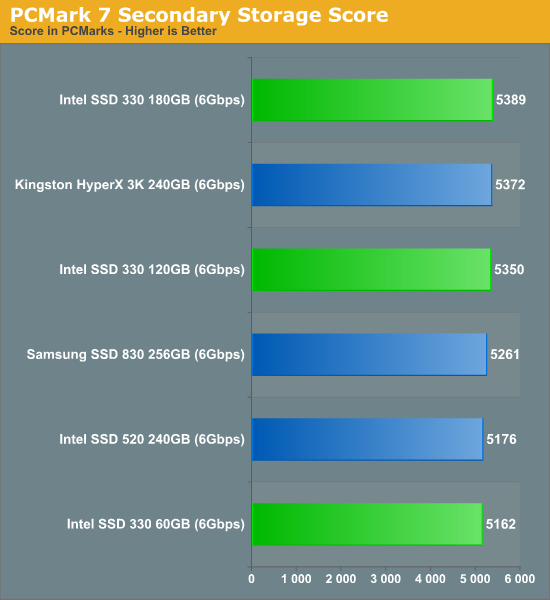The Intel SSD 330 Review (60GB, 120GB, 180GB)
by Anand Lal Shimpi on August 1, 2012 12:01 AM ESTPCMark 7
PCMark 7's secondary storage benchmark does little to show us differences between modern, high-performance SSDs as everything here scores within 5% of one another - but that's the point. For most mainstream client uses you'd be hard pressed to tell the difference between two good 6Gbps SSDs. Worry more about cost and reliability than outright performance if you're considering an SSD for a normal machine. Anything you see here will be much faster than a mechanical drive.

Performance Over Time & TRIM
SandForce's controllers have always behaved poorly if you pushed them into their worst case scenario. Should you fill a SF-2281 based drive completely with incompressible data then continue to write to the drive with more incompressible data (overwriting some of what you've already written) to fill up the spare area you'll back the controller into a corner that it can't get out of, even with TRIM. It's not a terribly realistic situation since anyone using an SF-2281 SSD as a boot drive will at least have Windows (or some other easily compressible OS) installed, and it's fairly likely that you'll have other things stored on your SSD in addition to large movies/photos. Regardless, it's a corner case that we do have to pay attention to.
As we found out in our 520 review, Intel's firmware isn't immune to this corner case. I filled a 120GB SSD 330 with incompressible data. I then ran a 60 minute 4KB random write torture test (QD32), once again, with incompressible data. Normally I'd use HDTach to chart performance over time however HDTach measures performance with highly compressible data so we wouldn't get a good representation of performance here. Instead I ran AS-SSD to get a good idea for incompressible sequential performance in this worst case state. Afterwards, I TRIMed the drives and ran AS-SSD again to see if TRIM could recover the drive's performance.
| Intel SSD 330 - Resiliency - AS SSD Sequential Write Speed - 6Gbps | |||||
| Clean | After Torture | After TRIM | |||
| Intel SSD 330 120GB | 148.9 MB/s | 96.3 MB/s | 94.4 MB/s | ||
This is really the biggest problem with SandForce drives. If you're primarily storing large amounts of incompressible data, sequential write speeds suffer even further over the long haul.










64 Comments
View All Comments
antef - Wednesday, August 1, 2012 - link
And, holy crap, Anand's chart is wrong, the m4 128 GB is now only $106 at Amazon. That's a steal!nextel2010 - Tuesday, October 2, 2012 - link
At this moment, Amazon has the Samsung 830 128GB at $89.99!! If I didn't already have a 128GB and 256GB already, I'm all over that one....owned66 - Wednesday, August 1, 2012 - link
i have 2 of these in raid 0HD tune bench it stays at 1000 MB/s then goes up and down then stays at 700 MB/s then goes back to 1000
im using a x77 motherboard
and also using the 6Gb/s port (not the marvell one)
Movieman420 - Wednesday, August 1, 2012 - link
I've been following the SSD endurance thread at XS for some time. There's one 64gb M4 that hit 0 MWI at 172TB of writes and is still chugging along at 1,.250+ TBs (that's 1.25 PB!!). Ofc not every drive is the same. There is a chart of the currently running endurance tests on the last page or 2 usually. To sum it up...nand endurance is not an issue as Anand stated.They have a Samsung 830 that just hit 3PBs!....it's mwi said the nand was worn out at 828TB writes...lmao
MrSpadge - Wednesday, August 1, 2012 - link
It's disappointing to see this drive switch to 9.5 mm when actually any SSD could be 7 mm standard. And Intel were the first to offer this (although with that stupid voided warrenty).MarsMSJ - Wednesday, August 1, 2012 - link
Anand should of touched on OSX and Intel's new drives even at the risk of sounding like a broken record. There some of us praying for the day Intel comes out with a new drive that works on OSX.Unfortunately, Samsung appears to be your best bet on OSX. I used a 320 series 160 GB drive and it just behaved poorly when I was using 150 GB of it. Not sure if it had anything to do with Repair Disk. Every other day OSX would recommend I run it because it believed my drive was corrupt. Sometimes it would even boot me right into Disk Utility. I ran Lion and Windows 7 in VMware fusion.
Strangely enough, the 320 behaved like these 330s in their "run into a corner" scenario.
kaelynthedove78 - Wednesday, August 1, 2012 - link
I noticed that you tested with a highly non-standard configuration, with EIST disabled.Has the Sandforce bug that causes the performance to plummet if EIST is enabled been fixed?
Nobody in their right mind would run a home desktop/laptop with EIST disabled..
jwcalla - Wednesday, August 1, 2012 - link
Hmmm... this is interesting. Where can I find more info about this? I haven't noticed such behavior yet but maybe I haven't been looking hard enough.Kristian Vättö - Thursday, August 2, 2012 - link
It's been fixed from what I know, or at least Anand told me to just leave those enabled (my setup is running normal settings as you can see in some of our recent SSD reviews). Anand has probably just left those settings to be what they were before.mattlach - Wednesday, August 1, 2012 - link
I presume the Vertex 4 is not in the comparison table due to its poor read speed when reviewed by Anandtech?Anandtech still needs to revisit the Vertex 4. The two firmware releases since launch have completely transformed the drive, and I wouldn't be surprised to see it near the top.